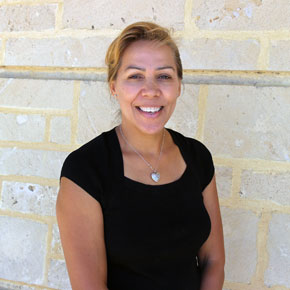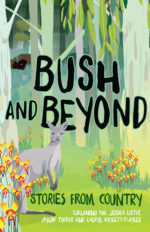From science to stories, Cheryl Kickett-Tucker on Bush and Beyond

Cheryl Kickett-Tucker is no ordinary children’s author. Once a community newspaper sports journalist, now a research scientist, associate professor and, most importantly, a writer of children’s fiction, Cheryl’s stories appear in Bush and Beyond, a collection of Indigenous stories with tales from Tjalaminu Mia, Jessica Lister and Jaylon Tucker.
How important was the bush in your experience when you were growing up?
It was extremely important, it meant getting out in the open, breathing fresh air. It provided an opportunity to be in nature, learn about nature and hear stories about the old people. The bush is really important to learning about our culture. And being out in the bush meant getting family together, whether it was around a campfire or at home.
Bush and Beyond contains stories that feature family relationships quite heavily. Do you think these relationships are important for children?
Family relationships are so important to how kids learn. Parents are role models for their kids, in the way we act or the way we don’t act. And body language plays a big part in that – Aboriginal people communicate really well with body language. Body language is especially important when you’re telling stories.
Barlay! features the story of the woordatj, how old were you when you first heard that story?
I heard it from my mum when I was seven or eight. We were holidaying down in Katanning, and we went over a small hill where the woordatj lived. She’d tell us about the woordatj to make sure we went back to the car before it got dark.
Did you find the process of writing for children easy?
No, it was really hard actually. I’m a researcher, I have a doctorate, so I come from a background of Western scientific report writing. I had to change my whole way of thinking to write a creative children’s story.
You use quite a few Nyungar words (with English equivalents) in your stories. Why did you choose to do this?
I wanted to teach both Aboriginal and non-Aboriginal kids the Nyungar language. I do a lot of research that involves me working with kids, and lots of the Nyungar kids I talk to don’t even know their own language. I included Nyungar words in my story so that kids of all backgrounds would be introduced to the language, and to help Nyungar kids see they don’t have to be embarrassed about their own language. It’s a start towards them learning it, even if it’s just a few words.
What do you hope readers of Barlay! will learn from reading it?
These kinds of stories always have a moral – in mine it’s about being respectful of your elders and learning from them. There’s a smaller moral of being careful in the bush too, as I write about leaving a trail when you go walking in the bush. And I really hope kids will enjoy the story, that they’ll have fun reading it and enjoy the illustrations!
Bush and Beyond is available in all good bookstores and online, where you can also download the free teaching notes. For class sets of bookmarks and other free teaching activities, contact admin@fremantlepress.com.au.



